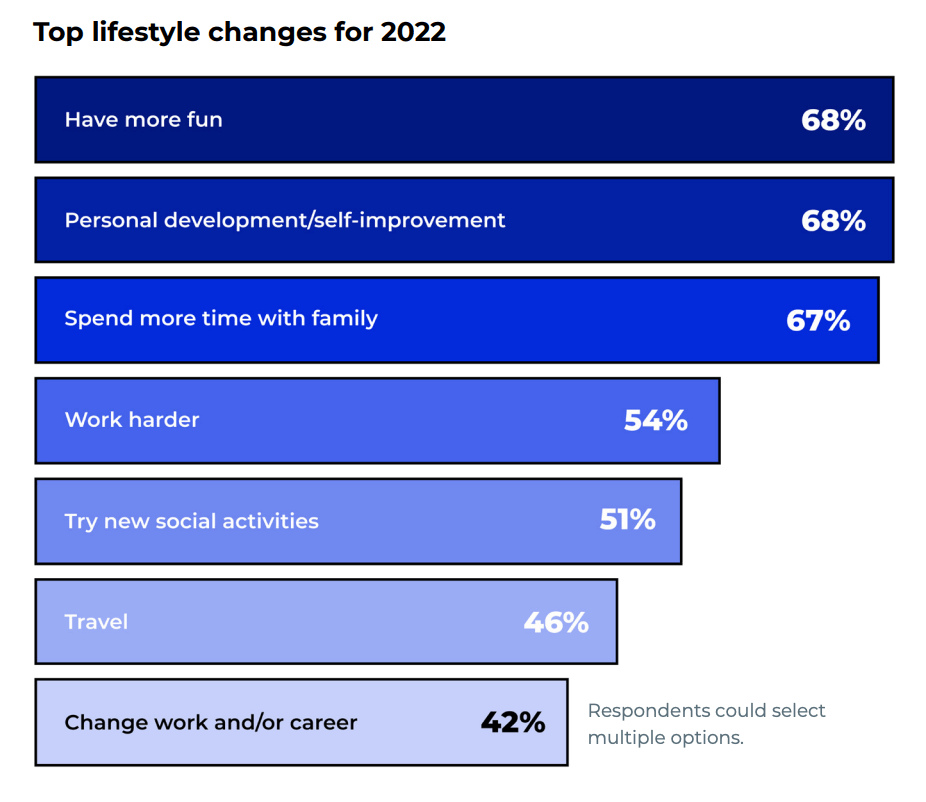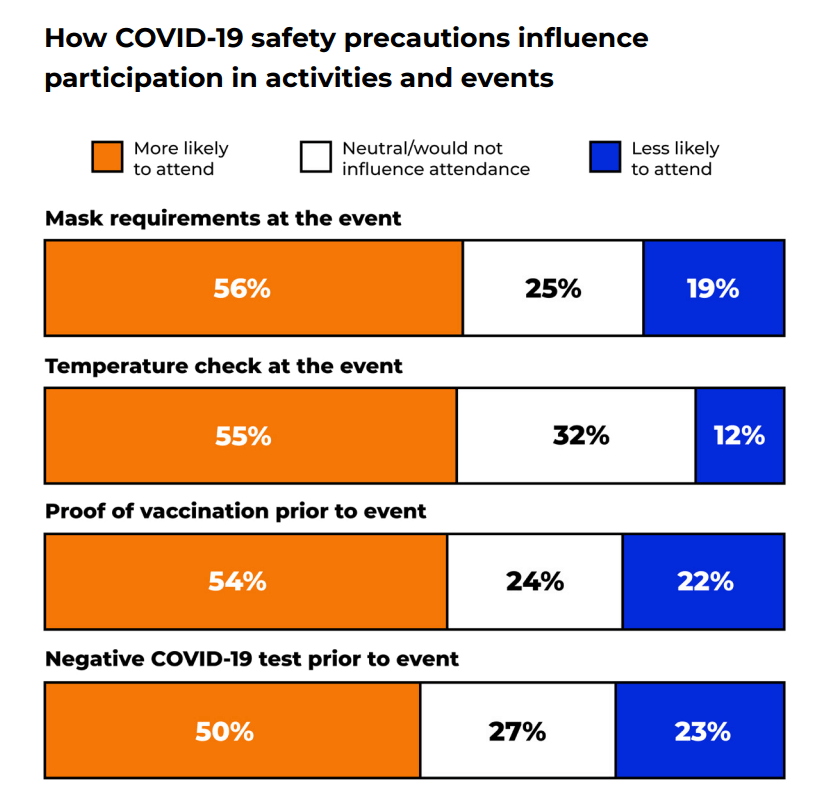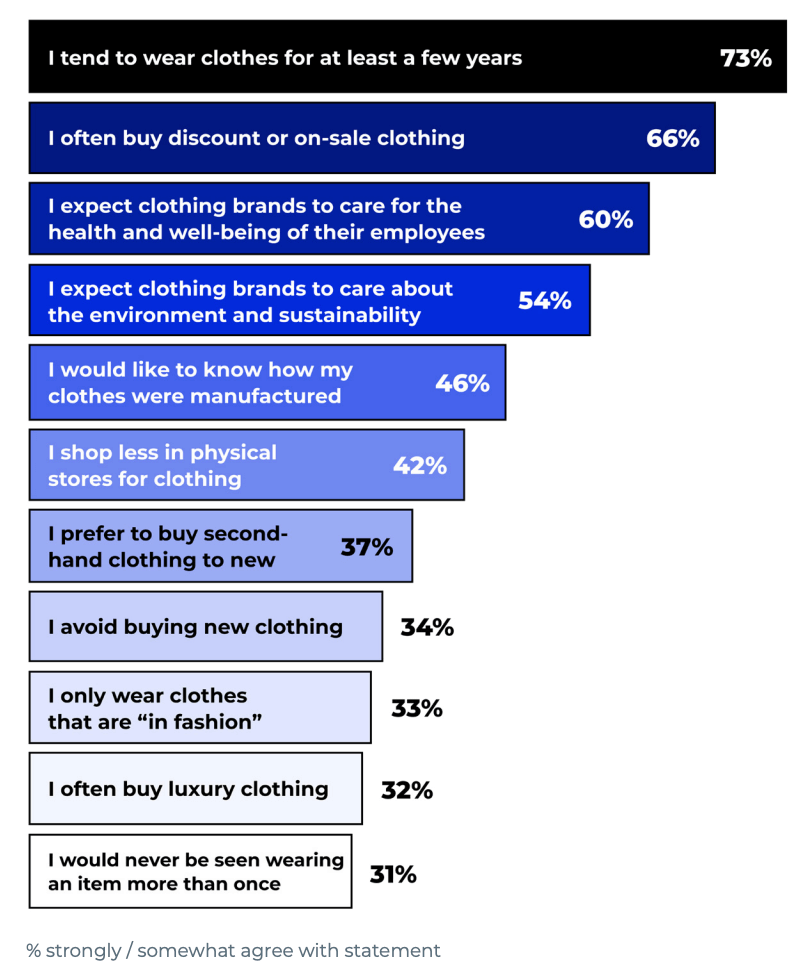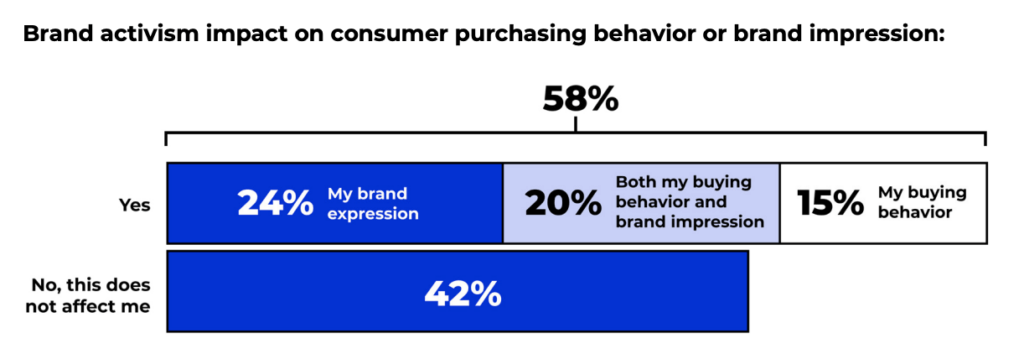According to Jungle Scout’s latest Consumer Trends Report, 55% of U.S. consumers say they’re looking forward to “treating themselves” in 2022 to make up for lost time due to the pandemic. 68% also want to have more fun in the new year. From travel to hobbies to clothing and self-care, industries that support leisure and entertainment can expect a wave of revenge shopping as Americans loosen their financial belts and reclaim fun in 2022.
What will people buy in 2022, where will they shop, and how? We’ll explore the post-pandemic consumer trends that will rule retail in the new year.
Consumers will spend on travel, social activities, and self-improvement in 2022
As with any upcoming new year, people are re-evaluating their lifestyles, looking for opportunities to improve how they spend their time at work and at leisure.
This year, the push toward self-improvement will run the gamut of personal development, changes to work and family life, as well as a concerted commitment to have more fun and indulge.

Post-pandemic travel trends and other activities
When it comes to treating themselves, many consumers now have a few more options than they did last year.
For one thing, traveling is more feasible now, thanks to many countries’ relaxed barriers to tourism. Travel is a top 2022 priority for 46% of U.S. consumers, many of whom have already booked vacations.
Whether they travel near or far, consumers will get more face-to-face time with their friends and families.
- 54% of consumers plan to visit relatives or families in 2022
- 50% plan to visit friends
- 24% plan to date in-person
- 21% will stay at a hotel or Airbnb
- 17% will take airplanes
They’ll also rejoin their broader communities through gatherings, entertainment events, and group classes.
- 30% of Americans plan to attend in-person church or religious services in 2022
- 28% will watch a movie, concert, or similar event at a public venue
- 27% will attend in-person sporting events
- 21% will go to a wedding
- 15% will go to a gym or fitness studio in-person
- 10% will participate in in-person group classes (e.g., cooking, dance)
While participation in public gatherings may fall well below pre-pandemic levels, it will still fuel 2022’s post-pandemic shopping.
Safety first: how consumers plan to socialize safely
At this point, depending on your location and worldview, you may be thinking, “Wait a minute, what do you mean ‘post-pandemic’ trends?”
While emerging COVID-19 variants mean the world isn’t out of the woods with the pandemic, many U.S. consumers are ready to move on. They’ve largely stepped away from the degree of isolation they experienced in the early days of the pandemic and are embracing new opportunities to socialize and spend. Whether you support the “post-pandemic” terminology or not, consumer trends in 2022 will look wildly different than they did the year prior.
That said, the majority of U.S. consumers say that these days, they’re actually more likely to attend an event if it involves some kind of COVID-related safety precaution. Whether it’s a requirement to wear masks, get their temperature taken, or show proof of vaccination or a negative COVID test, fewer than one-quarter of Americans say they’d be less likely to attend an event with mandatory safety compliance.

2021 lifestyle changes will also drive post-pandemic retail trends
2022 won’t be all play and no work. Americans are also looking to make the most of recent life changes, many of which will likely involve related purchases.
Everyday life has changed dramatically for many Americans this year — here’s a quick snapshot of how:
- 23% of U.S. consumers worked from home in 2021
- 19% adopted a new pet
- 17% changed jobs
- 7% welcomed a child
- 6% got engaged, and 4% got married
Add to that all the ways people changed their homes recently, and you’ve got plenty of to-do list items for January 1.
- 16% moved into a new home
- 13% renovated or remodeled their home
- 11% set up a home gym
- 7% bought a home
- 4% sold a home
Each of these activities will affect how consumers shop and spend in the new year.
What to expect from post-pandemic spending
When asked in early October 2021 about how they’d spend over the fall and winter months, roughly two-thirds of U.S. consumers expected their spending to either increase or stay the same as in Q3 of 2021 (July to September). One-third expected their spending to decrease. It’s reasonable to expect that, with their fuller social and travel calendars, Americans will continue on this positive trend toward increased consumer spending.
To make sure they and their families are set up for financial success, nearly three-quarters of Americans (73%) will also buckle down and examine their spending and budgets in 2022.
It’s important to remember that though reopened businesses have allowed the U.S. economy to recover somewhat from the initial shock of the COVID-19 outbreak in early 2020, the pandemic has affected millions of American families with job and income loss. So while spending is generally on the rise compared to earlier in the pandemic, some consumers may be more cautious about how much — and where — they spend moving forward.
Retail categories to watch in 2022
To support their 2022 endeavors — and to squeeze in some “treat yo’ self” spending — consumers will be shopping in a few key product categories. They’ll do much of that shopping online.
Travel products
After many homebound months, travelers will likely put some of their spending toward travel products like luggage, mobile power banks, and TSA-approved toiletries if they haven’t done so already. They’ll also shop for pandemic-era essentials like vaccine card protectors and camping equipment.
Self-care
The self-care industry boomed during the pandemic as people sought ways to relax amid a global crisis. Brands developed thousands of new products to support the skyrocketing interest in skincare, beauty routines, mindfulness, and meditation.
Consumers’ self-care habits have stuck around in a big way and have expanded to cover sleep, fitness, and nutrition, too. Products in these categories will continue to see high demand in the future.
Clothing
With new social and work obligations come new reasons to buy a fresh fit. As Americans venture out into public again to celebrate, strategize, and sweat together, retailers can expect more spending on clothing, particularly clothes related to formal events, nightlife, and fitness.
Back in Q3 of 2021, we asked consumers for more details about how they shop for clothing. Reflecting recent trending conversations about fast versus slow fashion and sustainability, the majority of shoppers said they keep the same clothes in rotation for at least a few years, buy clothes on sale, and care about how their clothes affect the environment. Over a third said they avoid buying new clothing and even prefer buying second-hand clothing.

However, a sizable chunk of shoppers identified as true fashionistas: they only wear clothes that are “in fashion,” they’d never be caught wearing the same item twice, and they often buy luxury clothing.
Luxury goods
In true “treat yo’ self” spirit, some shoppers will splurge on luxury goods. We’ve already seen a trend toward more extravagant spending: this year, one in five Americans is paying full-price for luxury holiday gifts.
Home decor, appliances, and other goods
As they shift jobs and move homes, Americans have more reasons to switch up their surroundings. Fun fact: 41% of the consumers that bought or moved into a new home in 2021 upgraded to a larger space, meaning more square footage to spruce. 29% downsized, which will likely also drive purchases, as people decide whether their existing furniture and appliances suit their new digs.
Retailers can look for more action in the categories related to new homes and jobs:
- Home decor and furniture
- Kitchen and home appliances
- Home office furniture and electronics
Consumers will shop online from conscious brands
Many consumers may have a post-pandemic mindset, but they’ll largely continue the pandemic trend of shopping online.
We asked shoppers where they’re likely to shop for certain product categories in the future — be it at staple retailers like Amazon and Walmart, or others — and noticed a strong trend toward online shopping in most categories. In fact, consumers are much more likely to shop online than in-store in most of the categories listed above.
- Exercise/fitness equipment: 104% more likely to shop online than in-store
- Electronics: 88%
- Home & Kitchen: 57%
- Office supplies: 59%
- Clothing: 37%
- Beauty & personal care: 25%
Consumers will likely visit their favorite online retailers, including Amazon and Walmart. Clothing shoppers will branch out to brands like American Eagle & Aerie (14% of U.S. consumers shop here) and Nike (13%), as well as platforms like Etsy (10%) and ASOS (9%).
There’s one big caveat to all this new 2022 spending that retailers should remember: brand activism heavily influences consumer purchases.
Americans increasingly feel that brands owe it to their audiences to take a stance on today’s political and social issues. 58% of consumers are influenced by a brand’s social activism — their impression of the brand and whether they choose to buy from it are affected by the brand’s messaging on divisive topics.

This holds true regarding how a brand treats its employees, whether it engages in environmentally-friendly practices, and whether its chosen causes and communities align with the consumer’s values.
Consumer trends and spending in 2022
As shoppers look toward the new year, they’re envisioning new adventures, opportunities to grow, and more quality time with loved ones. Whether they take the “treat yo’ self” route or a more frugal tack, retailers can expect more spending on the products and categories that support shoppers’ work-hard-play-hard approach to 2022.
For more insights on how Americans spend and shop, check out Jungle Scout’s Q4 2021 Consumer Trends Report.

 4 Comments
4 Comments
4 comments on “Treat Yo’ Self: Post-pandemic Consumer Trends”